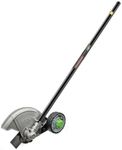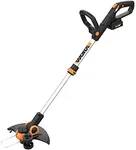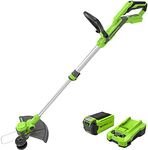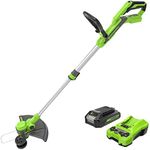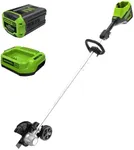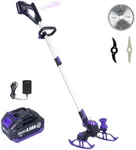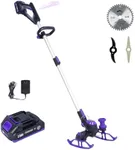Buying Guide for the Best Edgers
When it comes to picking the right edger for your lawn care needs, it's important to consider several key specifications that will help you make the best choice. Edgers are essential tools for creating clean, defined lines along the edges of your lawn, garden beds, and walkways. Understanding the different features and how they align with your specific needs will ensure you get the most effective and efficient tool for your yard work.Power SourceThe power source of an edger can be electric (corded or cordless) or gas-powered. Electric edgers are generally lighter, quieter, and require less maintenance, making them ideal for smaller yards and lighter tasks. Cordless models offer more mobility but have limited battery life. Gas-powered edgers are more powerful and suitable for larger yards or tougher jobs, but they are heavier, noisier, and require more maintenance. Choose based on the size of your yard and the intensity of the work you need to perform.
Blade TypeEdgers typically come with either a fixed blade or a rotating blade. Fixed blades are simpler and more durable, making them suitable for straightforward edging tasks. Rotating blades offer more versatility and can handle tougher, more intricate edging jobs. Consider the complexity of your lawn's edges and the types of materials you need to cut through when choosing the blade type.
Cutting DepthCutting depth refers to how deep the edger can cut into the ground. Adjustable cutting depth is a useful feature as it allows you to customize the depth based on your specific needs. For regular lawn maintenance, a shallow depth may suffice, but for creating new edges or dealing with overgrown areas, a deeper cutting depth will be necessary. Assess the condition of your lawn and the type of edging you plan to do to determine the appropriate cutting depth.
Cutting WidthCutting width is the width of the path that the edger can cut in a single pass. A wider cutting width can make the job faster, especially for larger areas, but it may be less precise for detailed work. Narrower cutting widths offer more precision and control, which is beneficial for intricate edging tasks. Consider the size of your lawn and the level of detail required when choosing the cutting width.
Weight and ManeuverabilityThe weight and maneuverability of an edger are important for ease of use, especially if you have a large area to cover or if you need to navigate around obstacles. Lighter edgers are easier to handle and reduce fatigue, making them suitable for smaller yards or less intensive tasks. Heavier models, while more powerful, can be more challenging to maneuver. Think about your physical strength, the layout of your yard, and how long you will be using the edger when considering weight and maneuverability.
Handle DesignThe design of the handle can greatly affect the comfort and control you have while using the edger. Look for ergonomic handles that provide a comfortable grip and reduce strain on your hands and arms. Adjustable handles can also be beneficial as they allow you to customize the height and angle to suit your body and the task at hand. Consider how long you will be using the edger and your personal comfort preferences when evaluating handle design.
